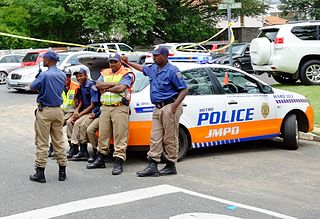The Republic of South Africa is a unitary parliamentary democratic republic. The President of South Africa serves both as head of state and as head of government. The President is elected by the National Assembly and must retain the confidence of the Assembly in order to remain in office. South Africans also elect provincial legislatures which govern each of the country's nine provinces.

A state of emergency is a situation in which a government is empowered to be able to put through policies that it would normally not be permitted to do, for the safety and protection of its citizens. A government can declare such a state during a natural disaster, civil unrest, armed conflict, medical pandemic or epidemic or other biosecurity risk. Justitium is its equivalent in Roman law—a concept in which the Roman Senate could put forward a final decree that was not subject to dispute yet helped save lives in times of strife.

Hendrik Frensch Verwoerd, also known as H. F. Verwoerd was a South African politician, a scholar of applied psychology and sociology, and chief editor of Die Transvaler newspaper. He is commonly regarded as the architect of Apartheid. Verwoerd played a significant role in socially engineering apartheid, the country's system of institutionalized racial segregation and white supremacy, and implementing its policies as Minister of Native Affairs (1950–1958) and then as prime minister (1958–1966). Furthermore, Verwoerd played a vital role in helping the far-right National Party come to power in 1948, serving as their political strategist and propagandist, becoming party leader upon his premiership. He was the Union of South Africa's last prime minister, from 1958 to 1961, when he proclaimed the founding of the Republic of South Africa, remaining its prime minister until his assassination in 1966.

The National Party, also known as the Nationalist Party, was a political party in South Africa founded in 1914 and disbanded in 1997. The party was an Afrikaner ethnic nationalist party that promoted Afrikaner interests in South Africa. However, in 1990 it became a South African civic nationalist party seeking to represent all South Africans. It first became the governing party of the country in 1924. It merged with its rival, the SAP, during the Great Depression, and a splinter faction became the official opposition during World War II and returned to power and governed South Africa from 4 June 1948 until 9 May 1994.

The Defiance Campaign against Unjust Laws was presented by the African National Congress (ANC) at a conference held in Bloemfontein, South Africa in December 1951. The Campaign had roots in events leading up the conference. The demonstrations, taking place in 1952, were the first "large-scale, multi-racial political mobilization against apartheid laws under a common leadership."

The Suppression of Communism Act, 1950, renamed the Internal Security Act in 1976, was legislation of the national government in apartheid South Africa which formally banned the Communist Party of South Africa and proscribed any party or group subscribing to communism, according to a uniquely broad definition of the term. It was also used as the basis to place individuals under banning orders, and its practical effect was to isolate and silence voices of dissent.
In South Africa, pass laws were a form of internal passport system designed to segregate the population, manage urbanization and allocate migrant labor. Also known as the natives' law, pass laws severely limited the movements of black African citizens, and other people as well by restricting them to designated areas. Before the 1950s, this legislation largely applied to African men; attempts to apply it to women in the 1910s and 1950s were met with significant protests. Pass laws were one of the dominant features of the country's apartheid system until it was effectively ended in 1986. The pass document used in the enforcement of these laws was pejoratively called the dompas.

Apartheid was a system of institutionalised racial segregation that existed in South Africa and South West Africa from 1948 to the early 1990s. Apartheid was characterised by an authoritarian political culture based on baasskap, which ensured that South Africa was dominated politically, socially, and economically through minoritarianism by the nation's dominant minority white population. According to this system of social stratification, white citizens had the highest status, followed by Indians and Coloureds, then black Africans. The economic legacy and social effects of apartheid continue to the present day, particularly inequality.
Group Areas Act was the title of three acts of the Parliament of South Africa enacted under the apartheid government of South Africa. The acts assigned racial groups to different residential and business sections in urban areas in a system of urban apartheid. An effect of the law was to exclude people of color from living in the most developed areas, which were restricted to Whites. It required many people of color to commute large distances from their homes to be able to work. The law led to people of color being forcibly removed for living in the "wrong" areas. The majority that was people of color, were given much smaller areas to live in than the white minority who owned most of the country. Pass Laws required people of color to carry pass books and later "reference books", similar to passports, to enter the "white" parts of the country.
The system of racial segregation and oppression in South Africa known as apartheid was implemented and enforced by many acts and other laws. This legislation served to institutionalize racial discrimination and the dominance by white people over people of other races. While the bulk of this legislation was enacted after the election of the National Party government in 1948, it was preceded by discriminatory legislation enacted under earlier British and Afrikaner governments. Apartheid is distinguished from segregation in other countries by the systematic way in which it was formalized in law.

Law enforcement in South Africa is primarily the responsibility of the South African Police Service (SAPS), South Africa's national police force. SAPS is responsible for investigating crime and security throughout the country. The "national police force is crucial for the safety of South Africa's citizens" and was established in accordance with the provisions of Section 205 of the Constitution of South Africa.

The National Key Points Act, 1980 is an act of the Parliament of South Africa that provides for the declaration and protection of sites of national strategic importance against sabotage, as determined by the Minister of Police since 2004 and the Minister of Defence before that. The act was designed during apartheid to secretly arrange protection primarily for privately owned strategic sites. It enables the government to compel private owners, as well as state-owned corporations, to safeguard such sites owned by them at their own cost. The act, still in force and unamended since apartheid, came under the spotlight after President Jacob Zuma's Nkandla homestead was declared a National Key Point in 2010 amid controversy over public expenditure on upgrades to the property. As of 2013, the act is officially under review.

Internal resistance to apartheid in South Africa originated from several independent sectors of South African society and took forms ranging from social movements and passive resistance to guerrilla warfare. Mass action against the ruling National Party (NP) government, coupled with South Africa's growing international isolation and economic sanctions, were instrumental in leading to negotiations to end apartheid, which began formally in 1990 and ended with South Africa's first multiracial elections under a universal franchise in 1994.
This article covers the history of the Pan Africanist Congress of Azania, once a South African liberation movement and now a minor political party.
Racism in South Africa can be traced back to the earliest historical accounts of interactions between African, Asian, and European peoples along the coast of Southern Africa. It has existed throughout several centuries of the history of South Africa, dating back to the Dutch colonization of Southern Africa, which started in 1652. Before universal suffrage was achieved in 1994, White South Africans, especially Afrikaners during the period of Apartheid, enjoyed various legally or socially sanctioned privileges and rights that were denied to the indigenous African peoples. Examples of systematic racism over the course of South Africa's history include forced removals, racial inequality and segregation, uneven resource distribution, and disenfranchisement. Racial controversies and politics remain major phenomena in the country.

The Riotous Assemblies Act, Act No 17 of 1956 in South Africa prohibited gatherings in open-air public places if the Minister of Justice considered they could endanger the public peace. Banishment was also included as a form of punishment.

The Unlawful Organizations Act No 34 of 1960 allowed the apartheid government of South Africa to declare unlawful any organizations deemed to threaten public order or the safety of the public. This legislation was enacted within a few weeks of 1960's Sharpeville Massacre. The African National Congress (ANC) and Pan Africanist Congress (PAC) were immediately declared unlawful, and the Indemnity Act that followed legislatively indemnified supporters of the apartheid regime from any wrongdoing connected to the massacre.

The Indemnity Act 61 of 1961 was a law enacted by the apartheid government in South Africa, which protected the government from any legal repercussions of the Sharpeville massacre and other violent events that followed. It prevented the courts from hearing any criminal charges or civil claims against the government, its leaders or its employees for actions taken between 21 March 1960 and 5 July 1961.
The Coloured vote constitutional crisis, also known as the Coloured vote case, was a constitutional crisis that occurred in the Union of South Africa during the 1950s as the result of an attempt by the Nationalist government to remove coloured voters in the Union's Cape Province from the common voters' rolls. It developed into a dispute between the judiciary and the other branches of government over the power of Parliament to amend an entrenched clause in the South Africa Act and the power of the Appellate Division to overturn the amendment as unconstitutional. The crisis ended when the government enlarged the Senate and altered its method of election, allowing the amendment to be successfully enacted.
South African administrative law is the branch of public law which regulates the legal relations of public authorities, whether with private individuals and organisations or with other public authorities, or better say, in present-day South Africa, which regulates "the activities of bodies that exercise public powers or perform public functions, irrespective of whether those bodies are public authorities in a strict sense." According to the Constitutional Court, administrative law is "an incident of the separation of powers under which the courts regulate and control the exercise of public power by the other branches of government."









